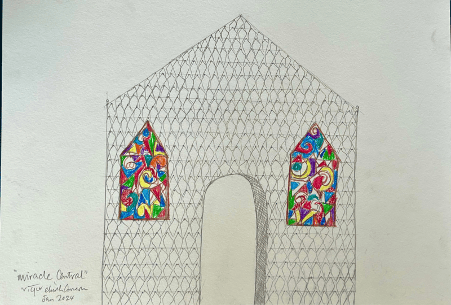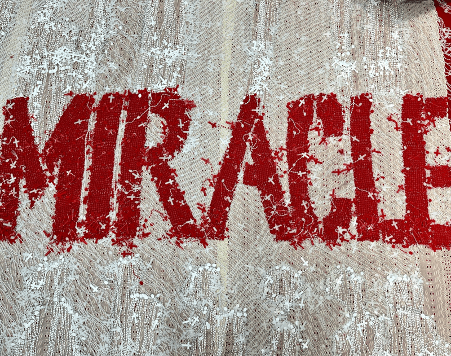

Victor Ehikhamenor, Miracle Central 2024, drawing of entrance, photo credit: Victor Ehikhamenor, Courtesy of VEE Studio
Victor Ehikhamenor, Miracle Central 2024, Courtesy of the artist
Born Udomi-Uwessan, Nigeria (1970), works and lives between Lagos, Nigeria and Maryland, USA
Miracle central 2024
mixed media installation
7.62m x 7.62m x 25.9m
Courtesy of the artist
The production of this work was supported by Victor Ehikhamenor Studio and Maruani Mercier Gallery.
Commissioned by Lagos Biennial 2024
Artist’s statement
Miracle Central is a mixed-media installation that uses the scale and grandeur of Tafawa Balewa Square as a basis for an experiential dialogue on the histories of religion and culture in Nigeria. Cladded with thousands of white handkerchiefs — emblematic of the pentecostal movement in Nigeria — the installation includes a work of rosaries sewn on lace fabric in my ongoing tapestry style, as well as paraphernalia of western and traditional worship suspended in the air. I formulate the dynamic enclosure as a site of refuge, in much the same way as a religious event or political rally can be.
With Miracle Central, I extend the focus of my ongoing interrogations on the duality found in expressions of religion and culture to Pentecostalism. Tafawa Balewa Square (TBS), originally built as a racecourse—which also served as the venue for Nigeria’s independence ceremony—has in recent decades become a key site for evangelical meetings, including one of the largest Christian music gatherings in the world. For instance, it was the location for a historic crusade by Archbishop Benson Idahosa, a foremost preacher from Benin City, whose ‘Expect a Miracle’ event brought scores of people to fill up the Square. The multi-purposing of TBS’s use is implied in the title of the installation, suggesting a space of supernatural, transformative encounters, and equally in the fusion of elements of both Catholicism and newer expressions of Africanized Christianity.
Miracle Central invites meditation on the hallowed space to be found at the intersections of religion, politics, history, and expressions of belonging. The scale of the piece and the site of its installation, as well as the range of its constituent elements, make it a necessary addition to an evaluation of how public space is charged and changed by what occupies it and what is enclosed by it.
Victor Ehikhamenor’s work is included in Gregarious architectures.









